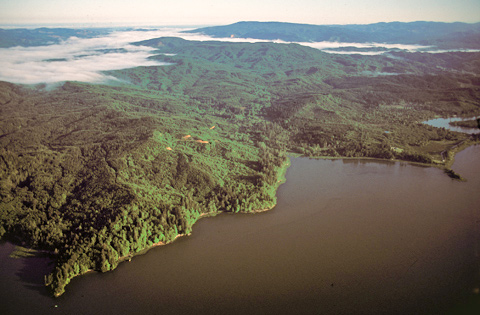Late on the morning of 8 November 1805, the Corps’ flotilla entered a “nitch” they called Shallow Bay (now called Grays Bay) and paused for their midday meal near the mouth of Deep River (at far right in photo). There they found the remains of an Indian village with “great numbers of flees which [we] treated with the greatest caution and distance.”
After lunch, rather than paddle straight across the broad bay, the company took advantage of the ebb tide and proceeded downriver “close under the Stard. Side.” It had been routine practice to avoid the swift current in a river’s main channel as much as possible, keeping to the slower water close to shore. This made navigation easier and gave ready access to shore. Here in the Columbia’s estuary, it was similarly prudent to stay close to shore, except that the driftwood there was bigger than any they had ever seen—some logs were two hundred feet long and seven feet in diameter. Moreover, the waves were too much for their dugouts, as the gunwales reached only a few inches above the water’s surface.
That evening, when high waves and swells forced them out of the water several miles downriver, the men confronted the problem of finding a campsite. “We have not leavel land sufficient for an encampment and for our baggage to lie Cleare of the tide,” complained Clark, “the High hills jutting in So Close and Steep that we cannot retreat back, and the water of the river too Salt to be used.”
In fact, one of the canoes was swamped in the waves before it could be unloaded. In Clark’s journal entry of 9 November he noted, “Notwithstanding the disagreeable time of the party for Several days past they are all Chearfull and full of anxiety to See further into the ocian.”
From Discovering Lewis & Clark from the Air
Photography by Jim Wark
Text by Joseph Mussulman
Reproduced by permission of Mountain Press
Experience the Lewis and Clark Trail
The Lewis and Clark Trail Experience—our sister site at lewisandclark.travel—connects the world to people and places on the Lewis and Clark Trail.
Discover More
- The Lewis and Clark Expedition: Day by Day by Gary E. Moulton (University of Nebraska Press, 2018). The story in prose, 14 May 1804–23 September 1806.
- The Lewis and Clark Journals: An American Epic of Discovery (abridged) by Gary E. Moulton (University of Nebraska Press, 2003). Selected journal excerpts, 14 May 1804–23 September 1806.
- The Lewis and Clark Journals. by Gary E. Moulton (University of Nebraska Press, 1983–2001). The complete story in 13 volumes.


